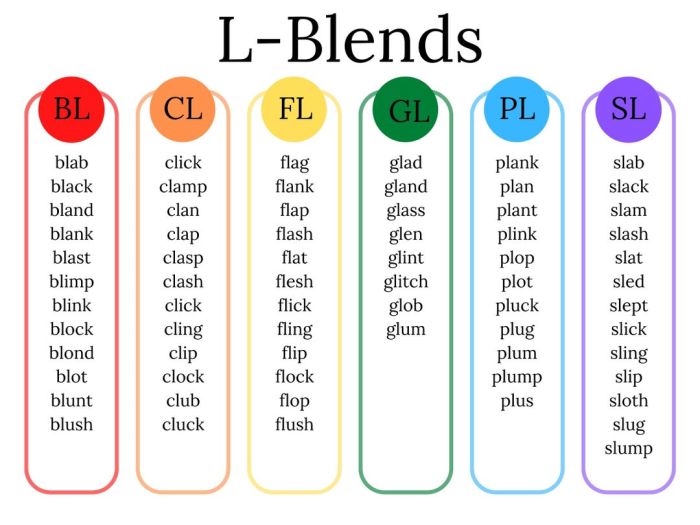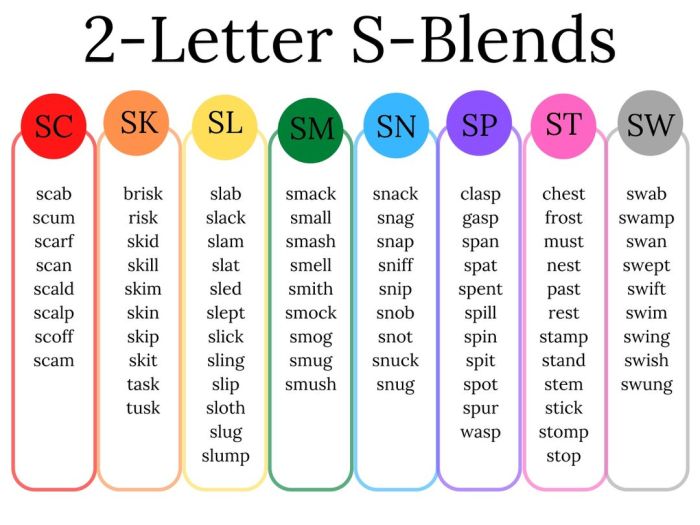Consonant blends with short vowels are an essential aspect of English pronunciation, adding complexity and richness to the spoken language. This guide will delve into the intricacies of these consonant clusters, exploring their types, pronunciation rules, and practical exercises to enhance fluency.
From the initial identification of consonant blends and short vowels to the mastery of pronunciation techniques, this comprehensive resource will empower learners to navigate the complexities of English phonetics.
Consonant Blends with Short Vowels

Consonant blends with short vowels are a common feature of the English language. Understanding these blends is essential for accurate pronunciation and reading fluency.
Definition of Consonant Blends with Short Vowels
A consonant blend is a combination of two or more consonant sounds pronounced together without an intervening vowel sound. Short vowels are vowel sounds that are pronounced quickly and have a short duration.
When a consonant blend occurs before a short vowel, it creates a distinct sound that can be difficult for learners to master.
Types of Consonant Blends with Short Vowels
There are various types of consonant blends that can occur with short vowels. The most common types include:
- Initial consonant blends:These blends occur at the beginning of a word, such as “bl” in “blue” or “tr” in “tree”.
- Medial consonant blends:These blends occur in the middle of a word, such as “nd” in “find” or “mp” in “jump”.
- Final consonant blends:These blends occur at the end of a word, such as “lt” in “salt” or “st” in “best”.
Pronunciation Rules for Consonant Blends with Short Vowels
There are certain pronunciation rules that apply to consonant blends with short vowels. These rules help ensure accurate and consistent pronunciation:
- Blend the consonants together:Pronounce the consonant sounds smoothly and without any separation.
- Keep the vowel sound short:The vowel sound should be pronounced quickly and have a short duration.
- Listen to native speakers:Pay attention to how native speakers pronounce these blends and try to imitate their pronunciation.
Examples of Words with Consonant Blends and Short Vowels
Here are some common words that contain consonant blends with short vowels:
| Consonant Blend | Examples |
|---|---|
| bl | blue, black, blind |
| tr | tree, train, truck |
| nd | find, sound, kind |
| mp | jump, lamp, camp |
| lt | salt, belt, felt |
| st | best, west, last |
Activities for Practicing Consonant Blends with Short Vowels
There are various activities that can help learners practice pronouncing and reading words with consonant blends and short vowels:
- Tongue twisters:Tongue twisters that incorporate consonant blends with short vowels can help improve pronunciation accuracy.
- Word games:Games such as “I Spy” or “Bingo” can be adapted to focus on words with consonant blends and short vowels.
- Reading aloud:Reading aloud passages or stories that contain words with consonant blends and short vowels can help learners improve their fluency and pronunciation.
Common Queries: Consonant Blends With Short Vowels
What are consonant blends?
Consonant blends are groups of two or more consonants that are pronounced together without intervening vowels.
What are short vowels?
Short vowels are vowel sounds that are pronounced quickly and without diphthongs. In English, the short vowels are /a/, /e/, /i/, /o/, and /u/.
How do I pronounce consonant blends with short vowels?
To pronounce consonant blends with short vowels, follow these general rules: – Pronounce the first consonant clearly and quickly. – Pronounce the second consonant lightly and without releasing it. – Blend the two consonants together without inserting a vowel sound.
